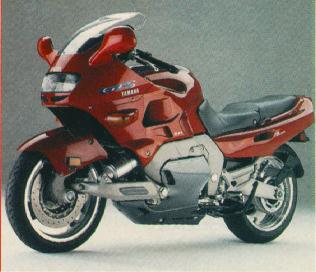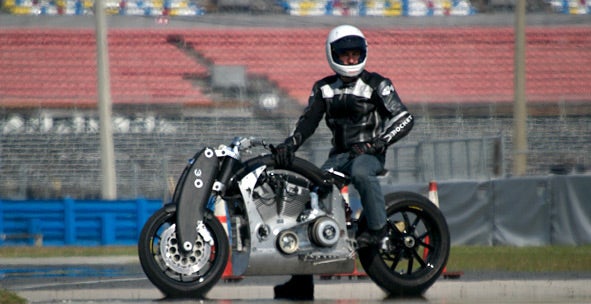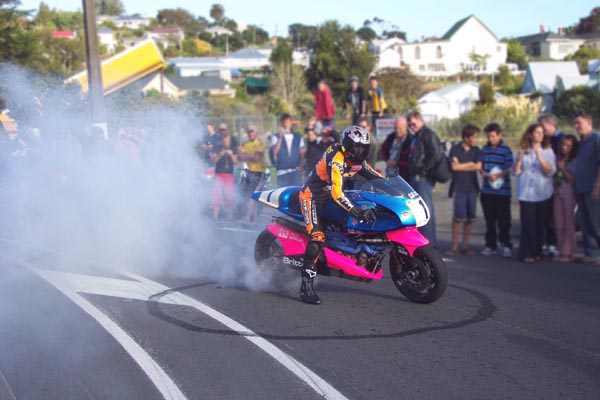| Author | Message | ||
Jaimec |
This is essentially a continuation of a discussion from here: http://www.badweatherbikers.com/buell/messages/290 431/317799.html?1195261679#POST1012410 Since I don't want to hijack that thread, but I do feel it is a worthy topic of discussion I wanted to pursue it here. Blake, Court has pointed out before that Buell does have a patent on an alternative front end. Why would he do this if he feels the telescopic fork is the end-all and be-all of front suspensions? Buell is, above all else, a BUSINESS, and historically (as I pointed out) if a motorcycle is too "different" it becomes a sales flop. In the alternative front end department you need look no further than the early 90's Yamaha GTS1000. BMW introduced their telelever around the same time, but the big difference was that to the untrained eye, it didn't look any different from the telescopic front ends everyone has grown accustomed to. I always felt Yamaha made a marketing faus pas by introducing Parker's RADD suspension in a semi-sport bike. I think they SHOULD have introduced it in a variation of their Venture Royale luxury touring bike. The reason being that luxury bike buyers LOVE new and different technology they can show off, and the extra price of the technology could've easily been absorbed in that market. Once it gained acceptance, they could've then experimented with other markets. The reason you don't see anti-dive technology in telescopic forks anymore is that they don't work, by the way. Every single one of them worked by changing the dampening characteristics of the fork during braking (Harley's technology was different and showed some promise... I'll get to that in a bit). That was great on smooth pavement, but in the real world, the pavement isn't smooth and the increase in dampening had an adverse effect on handling. In extreme conditions you could lengthen your braking distance because the front wheel would start skipping over the bumps instead of following the bumps. Harley had an "interesting" version of an anti-dive system. Their system in effect increased the compression characteristics of the fork. They used air to supplement the fork springs (as many large motorcycles did at that time). Interestingly enough, the air chamber for the fork continued into the "crash bars" of the bike to increase the volume of air available (most bikes used just the volume of air in the forks themselves which resulted in the air assist being "too progressive"). However, during braking, a valve would close off the air supply in the crash bars leaving just the air in the forks which would then limit the front end dive without affecting the dampening. I'm not sure why they abandoned the technology, other than MAYBE for the same reason most of the other manufacturers abandoning air suspensions; too much wear on the seals. Once your seals went, front end handling went right into the toilet since the springs alone weren't enough. As to why you don't see it in racing, I already answered that. There isn't enough information available on alternative front ends in racing, and there is a wealth of knowledge on how telescopic forks react. MOST companies go into racing to WIN, and you're more likely to win with known technology. Maybe someday more brave souls will experiment with alternative front ends like these guys: http://home.freeuk.com/steve.burge/index.html When they do, we'll all benefit. | ||
Anonymous |
Check and find the inventor's name on the H-D anti-dive patent. It was and is the best anti-dive for a conventional fork, and it had additional suspension tuning attributes, especially in the original FXRT version that had a diaphragm reservoir which was lost when the system went to using the crash bars. But it's a lot of parts for something that 99% of riders won't appreciate, and it wasn't cheap. And as far as different is concerned, you have to make sure that you aren't losing more than you are gaining. Many of the benefits seen in alternate front ends are more than outweighed by the negatives they have. Each different design must be studied in great detail to understand the pluses and minuses. For one example, the Tesi front end is quite heavy in unsprung weight and has a huge amount of connections that must stay tight to work properly. The results of these connections becoming looser is not fun. And we are talking simple bearing wear, not bolts being loose. Things that must be replaced frequently, not just tightened. Conventional is still here for three reasons: most alternatives are in reality not as good; conventionals of very high quality can be purchased at reasonable prices; and it is really hard to sell something radically different even if it is better. | ||
Jaimec |
Anony, that's why the Tesi front end scares me. I thought Parker's RADD design made far more sense. | ||
Wardan123 |
My father bought a Yamaha GTS100 RADD and it was one of the smoothest rides I can recall. I rode it from Naples Fl, to the Fl. Keys for a poker run and it was very nice. It was the Peterson Poker Run and my dad took all othe Yamaha stickers off and covered the one's on the tank with H-D decals and when asked I was to say it was a H-D prototype. More than one H-D guy liked it. Many more just walked away scratching their head. Most did notice the steering...  | ||
Court |
M1, THIS may help. >>>>talking simple bearing wear And not, correct me if I am wrong, excessive wear. I'd guess that the cumulative effects of many bearings and connections means that all the wear limits would need to be "derated". . . As a construction worker. . . . I grow exponentially concerned with each additional connection. (Message edited by court on November 18, 2007) | ||
Danger_dave |
I'm about to go and collect the first of the BMW press fleet I vill weport. The Honda Rune had a nice front end for an Ubercruiser. Something about point of diminishing return on raked front ends and the bushes doing all the work in a horizontally orientated plunger setup. Worked well, whatever. | ||
M1combat |
Was that for me Court? Just curious as I don't remember posting in this thread  . . | ||
Mainstreamer |
I find it interesting that BMW has abandoned their telelever system for the traditional telescoping fork in their premier line of High Performance (HP) models and their line of F800 mid-weights. Unusual for those folks to retreat from their own 'advanced technology'(they are German you know  ). They have also moved away from the electric servo assist braking system. This action puts them in line with every other manufacture. Why do you think they have done this? ). They have also moved away from the electric servo assist braking system. This action puts them in line with every other manufacture. Why do you think they have done this? | ||
Rubberdown |
Mainstreamer, The HP2 enduro has a conventional fork because is has over 10.5 inches of travel and the geometry and dimensions of the telelever was not feasible for that extreme application (plus the conventional fork was lighter). The R1200S, R1200R, R1200ST, R1200GS, and new HP2 Sport street/race bike have a telelever front end. I'm a big fan of the Telelever on street bikes, especially with a Ohlins boinker on it. (Message edited by rubberdown on November 19, 2007) (Message edited by rubberdown on November 19, 2007) | ||
Anonymous |
You forgot to mention 'Cheap to manufacture' hence improved profit for the manufacturer. Telescopic forks work but are a huge compromise, and are acknowledged as being inferior in theory to hub centre steering in almost every respect. Now that lightweight materials have caught up with the theory I hope more manufacturers start offering alternative front ends again soon Cost isn't the consideration when it comes to choosing telescopic forks; they are not a particularly cheap solution when looked at in context of the vehicle as a whole, as design considerations for them raise the price and complexity of many other components. However, having ridden every alternative, there are very, very few alternatives out there that allow the direct steering feel that seems required to operate a motorcycle at traction limits. The true center-hub bikes have never come close to bettering telescopic forks in measurable or subjective performance. As for the telescopic fork being a "huge compromise": All motorcycle front suspension/steering designs are compromises; currently, the telescopic fork is the one that offers the best balance of benefits and drawbacks. | ||
Court |
>>.Was that for me Court? No. It was a typo. Buell has always used state of the art front forks since I bought my 1990. There's an art involved in making those selections that requires one to be part engineering, part production cost accountant and part enthusiast. It's a science of "how do we get the performance we want in a package we can sell". I'm pretty impressed, as was the media at Laguna Seca, with what Buell has done. | ||
Jaimec |
The idea behind the F series motorcycles from BMW is to make a lower cost bike to introduce people to the brand. As such, they are built with off-the-shelf components to keep the costs down. For example, the turn signal assemblies interchange with the ones on the Buell tubers and XBs... I too am a BIG fan of the telelever front end. For one thing, they eliminate one particularly annoying and time-consuming piece of maintenance: steering bearing replacement. Actually, they don't ENTIRELY eliminate it. Every 65,000 miles they have to be cleaned and regreased (they use an automotive-style ball joint, not ball or roller bearings like everyone else). I believe the Duolever brings back the roller bearing, but I'm not sure. | ||
Jaimec |
By the way... BMW will soon be introducing a 1000cc IL4 they plan to use in WSBK. It'll be interesting to see what kind of front end it will have... | ||
Mainstreamer |
Jamiec and Rubberdown, I've owned a couple BMW's with telelever and have no complaint. I'm thinking a R1200S would be a nice adder to my garage. You have made the point better then I. If weight and cost are a key design factor, telelever is not the first choice. | ||
Jaimec |
Actually, BMW campaigns a telelever-equipped R1200S in Moto-ST already, now that I think of it... | ||
Mbsween |
Guys, Anybody ever read Tim Hannah's book on Britten? Andrew Stroud on pg 256 comments that
Britten was the last bike I can recall in any sort of competitive event with a way different front end design. Okay and the BMW tele-lever. I think Anony nailed it, the telescopic fork sets the bar high and is reasonable to manufacturer and maintain. Unless another solution has both of those bases covered and then some, we're stuck with the telescopic fork. I think if a "new" front end is going to appear , it'll be in MotoGP where money goes to be burned. And I'd bet on Honda given the R&D muscle they have. | ||
Jaimec |
I'm going to have to go back and look at photos of Britten's baby. For some reason, I don't remember it having an alternative front end... | ||
Glitch |
 | ||
Barker |
 | ||
Jaimec |
Thanks. From the photo it looks like a Hossack style front end with a steering damper attached. The Confederate in the bottom photo uses a similar arrangement. Cool stuff! | ||
Danger_dave |
I've had a quick play on one. Only round a car park though. Shawn Harris giving it the berries:  I've had a BMW R1200S with the anti-dive front end for the last week. It works well. Has a bit of a dipsy-doodle between gear changes - but the whole front end is very nice. Couldn't say better or worse than conventional - just nice. Makes for different riding with the no dive thing. I utilise the way the XB12X drops its nose into corners. Adopt a whole motard kiss the mirrors counter-steering style. It's all bum-off-seat stuff with no change in pitch. Interesting. | ||
Glitch |
I've had a quick play on one. I'm envious | ||
Aesquire |
For years, I had a Mert Lawwill front fork on my mountain bike. http://www.bikepro.com/products/forks/lawill_index .html Look familiar? It's obsolete now, but I sold my bike to a buddy who scrapped the frame & kept the fork. Absolutely solid in steering, great on the brakes, built like a brick. It took a decade or more before I found a conventional that I liked as much. | ||
Danger_dave |
>I'm envious< Nah - helped load one on a truck, mate. |